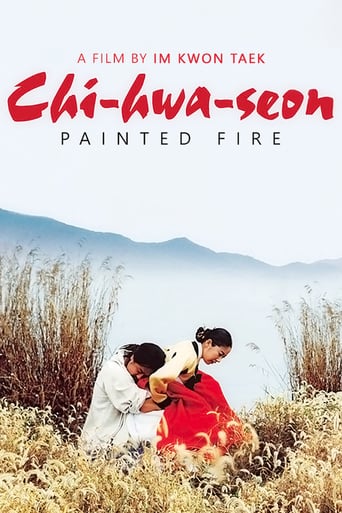refresh daemon
This film, winning Im Kwon-Taek the Best Director at Cannes in 2002 (tied with P.T. Anderson for Punch-Drunk Love), is about a 19th century Korean painter with a commoner's roots and significant impact on Korean painting. One of the strengths?of the film is that Im tries to help us see with the eye of a painter, so we see multiple scenes and objects which help our drunken painter friend, Jang Seung-up (Choi Min-shik),?receive inspiration.The costumes and the art direction are all impressive and the acting is even along being good. It's not a movie that moved me, but it was one that made me think about art and what it means to find your own voice in it. That's pretty cool. It's also interesting to see a version of Korea during those times right before the turn of the century, where Chinese and Japanese powers are both in Korea and the Chosun kingdom is coming to an end. More than one revolution and political ideology are gathered in the film, but are never the center. It's firmly on the painter.In the end, it's a well made film about the life of a painter. But it doesn't exactly have the regular three-act structure plot, so you have to be able to take a non-standard Hollywood story to watch it. Yay for art! 8/10
pipelineclub
inspite of many movies dealing with great artists or a genius, chihaweseon pointed out the real dilemma in which an artist is capted...the decision whether to ease the demands of the popularity or to create something new and to define ones' own style.Chiahweson's desperate seek for inspiration and broadening his conscious led him to live the way he did, restless, outrageous, and yes very drunk! But still he defended and retained the most important ethical rules for an artist: respect to his Master, respect to the nature and the gradual seek for improvement and to perfection.
grizzlygrrl
Not sure why the other comment on this film was so negative, but I loved this movie. I am a student of Asian art with a particular love of Korean art, culture and history. I thought this movie borough a very controversial and interesting character to life. Jang Seung-up is one of the (maybe the most) famous Korean artist and continues to be revered as a master. Given the tumult of the time in which he painted and his own conflicted nature, it is amazing that he produced so much work, in so many styles and with such skill. This movie honors his talent while taking a direct look at his erratic and somewhat self-destructive personality. The cinematography in MY opinion was beautiful, many of the outdoor panoramic shots looked like Korean landscape paintings (which I found a lovely conceit rather than "overly arty") and I think that Choi Min-sik portrayed Jang Seun-up with a necessary intensity and unpredictability. I would highly recommend this film to art lovers and movie lovers alike.
kayoblue
This movie could be a bit boring for some people, but I find this filmvery interesting in terms of an attempt to reveal a tradition.The director, Lim, has made two films about traditional music in Korea before this film. The film before this one was showing the music throughout the film, and this film is trying to achieve similar things by having backgrounds in the movie just like a painting.Another thing is that, the story is written by both director and a philosopher, Kim who is well known scholar in Korea (holding a lot of degrees - including doctor at Havard) I'm not saying that educated people make better films but that philosopher is an expert in traditional culture in Korea, so it gives more credit on this film.



